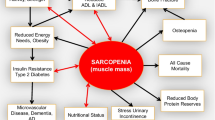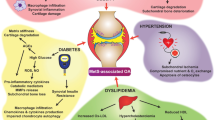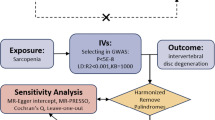Abstract
Purpose
Familial dysautonomia (FD) is associated with a high prevalence of bone fractures, but the impacts of the disease on bone mass and quality are unclear. The purpose of this study was to evaluate tissue through whole-bone scale bone quality in a mouse model of FD.
Methods
Femurs from mature adult Tuba1a-Cre; Elp1LoxP/LoxP conditional knockouts (CKO) (F = 7, M = 4) and controls (F = 5, M = 6) were evaluated for whole-bone flexural material properties, trabecular microarchitecture and cortical geometry, and areal bone mineral density (BMD). Adjacent maps spanning the thickness of femur midshaft cortical bone assessed tissue-scale modulus (nanoindentation), bone mineralization, mineral maturity, and collagen secondary structure (Raman spectroscopy).
Results
Consistent with prior studies on this mouse model, the Elp1 CKO mouse model recapitulated several key hallmarks of human FD, with one difference being the male mice tended to have a more severe phenotype than females. Deletion of Elp1 in neurons (using the neuronal-specific Tuba1a-cre) led to a significantly reduced whole-bone toughness but not strength or modulus. Elp1 CKO female mice had reduced trabecular microarchitecture (BV/TV, Tb.Th, Conn.D.) but not cortical geometry. The mutant mice also had a small but significant reduction in cortical bone nanoindentation modulus. While bone tissue mineralization and mineral maturity were not impaired, FD mice may have altered collagen secondary structure. Changes in collagen secondary structure were inversely correlated with bone toughness. BMD from dual-energy x-ray absorptiometry (DXA) was unchanged with FD.
Conclusion
The deletion of Elp1 in neurons is sufficient to generate a mouse line which demonstrates loss of whole-bone toughness, consistent with the poor bone quality suspected in the clinical setting. The Elp1 CKO model, as with human FD, impacts the nervous system, gut, kidney function, mobility, gait, and posture. The bone quality phenotype of Elp1 CKO mice, which includes altered microarchitecture and tissue-scale material properties, is complex and likely influenced by these multisystemic changes. This mouse model may provide a useful platform to not only investigate the mechanisms responsible for bone fragility in FD, but also a powerful model system with which to evaluate potential therapeutic interventions for bone fragility in FD patients.


Similar content being viewed by others
References
Riley CM, Day RL (1949) Central autonomic dysfunction with defective lacrimation; report of five cases. Pediatrics. 3:468–478
Slaugenhaupt SA, Blumenfeld A, Gill SP, Leyne M, Mull J, Cuajungco MP, Liebert CB, Chadwick B, Idelson M, Reznik L (2001) Tissue-specific expression of a splicing mutation in the IKBKAP gene causes familial dysautonomia. Am J Hum Genet 68:598–605
Maayan C, Kaplan E, Shachar SH, Peleg O, Godfrey S (1987) Incidence of familial dysautonomia in Israel 1977–1981. Clin Genet 32:106–108
Anderson SL, Coli R, Daly IW, Kichula EA, Rork MJ, Volpi SA, Ekstein J, Rubin BY (2001) Familial dysautonomia is caused by mutations of the IKAP gene. Am J Hum Genet 68:753–758
Lefcort F, Mergy M, Ohlen SB, Ueki Y, George L (2017) Animal and cellular models of familial dysautonomia. Clin Auton Res 27:235–243. https://doi.org/10.1007/s10286-017-0438-2
Cuajungco MP, Leyne M, Mull J, Gill SP, Lu W, Zagzag D, Axelrod FB, Maayan C, Gusella JF, Slaugenhaupt SA (2003) Tissue-specific reduction in splicing efficiency of IKBKAP due to the major mutation associated with familial dysautonomia. Am J Hum Genet 72:749–758
Boone N, Loriod B, Bergon A, Sbai O, Formisano-Tréziny C, Gabert J, Khrestchatisky M, Nguyen C, Féron F, Axelrod FB (2010) Olfactory stem cells, a new cellular model for studying molecular mechanisms underlying familial dysautonomia. PLoS One 5:e15590
Chaverra M, George L, Mergy M, Waller H, Kujawa K, Murnion C, Sharples E, Thorne J, Podgajny N, Grindeland A (2017) The familial dysautonomia disease gene IKBKAP is required in the developing and adult mouse central nervous system. Dis Model Mech 10:605–618
Saper CB (2002) The central autonomic nervous system: conscious visceral perception and autonomic pattern generation. Annu Rev Neurosci 25:433–469. https://doi.org/10.1146/annurev.neuro.25.032502.111311
Beissner F, Meissner K, Bär K-J, Napadow V (2013) The autonomic brain: an activation likelihood estimation meta-analysis for central processing of autonomic function. J Neurosci 33:10503–10511
Norcliffe-Kaufmann L, Axelrod F, Kaufmann H (2010) Afferent baroreflex failure in familial dysautonomia. Neurology. 75:1904–1911
Grünebaum M (1974) Radiological manifestations in familial dysautonomia. Am J Dis Child 128:176–178. https://doi.org/10.1001/archpedi.1974.02110270050010
Filler J, Smith AA, Stone S, Dancis J (1965) Respiratory control in familial dysautonomia. J Pediatr 66:509–516
Laplaza FJ, Turajane T, Axelrod FB, Burke SW (2001) Nonspinal orthopaedic problems in familial dysautonomia (Riley-Day syndrome). J Pediatr Orthop 21:229–232. https://doi.org/10.1097/00004694-200103000-00019
Palma J-A, Norcliffe-Kaufmann L, Fuente-Mora C, Percival L, Mendoza-Santiesteban C, Kaufmann H (2014) Current treatments in familial dysautonomia. Expert Opin Pharmacother 15:2653–2671. https://doi.org/10.1517/14656566.2014.970530
Hernandez CJ, Keaveny TM (2006) A biomechanical perspective on bone quality. Bone. 39:1173–1181
Boskey AL, Imbert L (2017) Bone quality changes associated with aging and disease: a review. Ann N Y Acad Sci 1410:93–106. https://doi.org/10.1111/nyas.13572
Maayan C, Bar-On E, Foldes AJ, Gesundheit B, Pollak RD (2002) Bone mineral density and metabolism in familial dysautonomia. Osteoporos Int 13:429–433. https://doi.org/10.1007/s001980200050
Bar-On E, Floman Y, Sagiv S, Katz K, Pollak RD, Maayan C (2000) Orthopaedic manifestations of familial dysautonomia : a review of one hundred and thirty-six patients. JBJS. 82:1563–1570
Dietrich P, Dragatsis I (2016) Familial dysautonomia: mechanisms and models. Genet Mol Biol 39:497–514. https://doi.org/10.1590/1678-4685-GMB-2015-0335
Kaplan L, Marguilies JY, Kadari A, Floman Y, Robin GC (1997) Aspects of spinal deformity in familial dysautonomia (Riley-Day syndrome). Eur Spine J 6:33–38
Krausz Y, Maayan C, Faber J, Marciano R, Mogle P, Wynchank S (1994) Scintigraphic evaluation of esophageal transit and gastric emptying in familial dysautonomia. Eur J Radiol 18:52–56
Norcliffe-Kaufmann L, Axelrod FB, Kaufmann H (2013) Developmental abnormalities, blood pressure variability and renal disease in Riley Day syndrome. J Hum Hypertens 27:51–55. https://doi.org/10.1038/jhh.2011.107
Blumenfeld A, Slaugenhaupt SA, Liebert CB, Temper V, Maayan C, Gill S, Lucente DE, Idelson M, MacCormack K, Monahan MA (1999) Precise genetic mapping and haplotype analysis of the familial dysautonomia gene on human chromosome 9q31. Am J Hum Genet 64:1110–1118
Ketteler M, Block GA, Evenepoel P, Fukagawa M, Herzog CA, McCann L, Moe SM, Shroff R, Tonelli MA, Toussaint ND, Vervloet MG, Leonard MB (2017) Executive summary of the 2017 KDIGO chronic kidney disease–mineral and bone disorder (CKD-MBD) Guideline Update: what’s changed and why it matters. Kidney Int 92:26–36. https://doi.org/10.1016/j.kint.2017.04.006
George L, Chaverra M, Wolfe L, Thorne J, Close-Davis M, Eibs A, Riojas V, Grindeland A, Orr M, Carlson GA (2013) Familial dysautonomia model reveals Ikbkap deletion causes apoptosis of Pax3+ progenitors and peripheral neurons. Proc Natl Acad Sci 110:18698–18703
Ueki Y, Ramirez G, Salcedo E, Stabio ME, Lefcort F (2016) Loss of Ikbkap causes slow, progressive retinal degeneration in a mouse model of familial dysautonomia. eNeuro 3:ENEURO.0143-16.2016. https://doi.org/10.1523/ENEURO.0143-16.2016
Morini E, Dietrich P, Salani M, Downs HM, Wojtkiewicz GR, Alli S, Brenner A, Nilbratt M, LeClair JW, Oaklander AL, Slaugenhaupt SA, Dragatsis I (2015) Sensory and autonomic deficits in a new humanized mouse model of familial dysautonomia. Hum Mol Genet 25:1116–1128. https://doi.org/10.1093/hmg/ddv634
Dietrich P, Alli S, Shanmugasundaram R, Dragatsis I (2012) IKAP expression levels modulate disease severity in a mouse model of familial dysautonomia. Hum Mol Genet 21:5078–5090. https://doi.org/10.1093/hmg/dds354
Jackson MZ, Gruner KA, Qin C, Tourtellotte WG (2014) A neuron autonomous role for the familial dysautonomia gene ELP1 in sympathetic and sensory target tissue innervation. Development. 141:2452–2461
Chen Y-T, Hims MM, Shetty RS, Mull J, Liu L, Leyne M, Slaugenhaupt SA (2009) Loss of mouse Ikbkap, a subunit of elongator, leads to transcriptional deficits and embryonic lethality that can be rescued by human IKBKAP. Mol Cell Biol 29:736–744
Dietrich P, Yue J, Shuyu E, Dragatsis I (2011) Deletion of exon 20 of the familial dysautonomia gene Ikbkap in mice causes developmental delay, cardiovascular defects, and early embryonic lethality. PLoS One 6:e27015
Turner CH, Burr DB (1993) Basic biomechanical measurements of bone: a tutorial. Bone. 14:595–608. https://doi.org/10.1016/8756-3282(93)90081-K
Heveran CM, Ortega AM, Cureton A, Clark R, Livingston EW, Bateman TA, Levi M, King KB, Ferguson VL (2016) Moderate chronic kidney disease impairs bone quality in C57Bl/6J mice. Bone. 86:1–9. https://doi.org/10.1016/j.bone.2016.02.006
Bouxsein ML, Boyd SK, Christiansen BA, Guldberg RE, Jepsen KJ, Müller R (2010) Guidelines for assessment of bone microstructure in rodents using micro-computed tomography. J Bone Miner Res 25:1468–1486. https://doi.org/10.1002/jbmr.141
Heveran CM, Schurman CA, Acevedo C, Livingston EW, Howe D, Schaible EG, Hunt HB, Rauff A, Donnelly E, Carpenter RD, Levi M, Lau AG, Bateman TA, Alliston T, King KB, Ferguson VL (2019) Chronic kidney disease and aging differentially diminish bone material and microarchitecture in a. Bone. 127:91–103. https://doi.org/10.1016/j.bone.2019.04.019
Ebenstein DM, Pruitt LA (2006) Nanoindentation of biological tissues. Nano Today 1:26–33
Oliver WC, Pharr GM (1992) An improved technique for determining hardness and elastic modulus using load and displacement sensing indentation experiments. J Mater Res 7:1564–1583
Ferguson VL, Bushby AJ, Boyde A (2003) Nanonmechanical properties and mineral concentration in articular calcified cartilage and subchondral bone. J Anat 203:191–202. https://doi.org/10.1046/j.1469-7580.2003.00193.x
Unal M, Jung H, Akkus O (2016) Novel raman spectroscopic biomarkers indicate that postyield damage denatures bone’s collagen. J Bone Miner Res 31:1015–1025. https://doi.org/10.1002/jbmr.2768
Ferguson VL, Ayers RA, Bateman TA, Simske SJ (2003) Bone development and age-related bone loss in male C57BL/6J mice. Bone. 33:387–398. https://doi.org/10.1016/S8756-3282(03)00199-6
Halloran BP, Ferguson VL, Simske SJ, Burghardt A, Venton LL, Majumdar S (2002) Changes in bone structure and mass with advancing age in the male C57BL/6J mouse. J Bone Miner Res 17:1044–1050. https://doi.org/10.1359/jbmr.2002.17.6.1044
De Winter JFC, Dodou D (2010) Five-point likert items: t test versus Mann-Whitney-Wilcoxon (Addendum added October 2012). Pract Assess Res Eval 15:11
Fay MP, Proschan MA (2010) Wilcoxon-Mann-Whitney or t-test? On assumptions for hypothesis tests and multiple interpretations of decision rules. Stat Surv 4:1–39. https://doi.org/10.1214/09-SS051
Sullivan GM, Artino AR Jr (2013) Analyzing and interpreting data from likert-type scales. J Grad Med Educ 5:541–542. https://doi.org/10.4300/JGME-5-4-18
Glatt V, Canalis E, Stadmeyer L, Bouxsein ML (2007) Age-related changes in trabecular architecture differ in female and male C57BL/6J mice. J Bone Miner Res 22:1197–1207. https://doi.org/10.1359/jbmr.070507
Somerville JM, Aspden RM, Armour KE, Armour KJ, Reid DM (2004) Growth of C57Bl/6 Mice and the material and mechanical properties of cortical bone from the tibia. Calcif Tissue Int 74:469–475. https://doi.org/10.1007/s00223-003-0101-x
Ab-Lazid R, Perilli E, Ryan MK, Costi JJ, Reynolds KJ (2014) Does cancellous screw insertion torque depend on bone mineral density and/or microarchitecture? J Biomech 47:347–353. https://doi.org/10.1016/j.jbiomech.2013.11.030
Perilli E, Briggs AM, Kantor S, Codrington J, Wark JD, Parkinson IH, Fazzalari NL (2012) Failure strength of human vertebrae: prediction using bone mineral density measured by DXA and bone volume by micro-CT. Bone. 50:1416–1425. https://doi.org/10.1016/j.bone.2012.03.002
Karim L, Vashishth D (2011) Role of trabecular microarchitecture in the formation, accumulation, and morphology of microdamage in human cancellous bone. J Orthop Res 29:1739–1744. https://doi.org/10.1002/jor.21448
Bahar H, Gallacher K, Downall J, Nelson CA, Shomali M, Hattersley G (2016) Six weeks of daily abaloparatide treatment increased vertebral and femoral bone mineral density, microarchitecture and strength in ovariectomized osteopenic rats. Calcif Tissue Int 99:489–499. https://doi.org/10.1007/s00223-016-0171-1
Eddy DM, Johnston J, Cummings SR, Dawson-Hughes B, Lindsay R, Melton LJ, Slemenda CW (1998) Osteoporosis: review of the evidence for prevention, diagnosis, and treatment and cost-effectiveness analysis. Status report. Osteoporos Int 8:I-S82
Norcliffe-Kaufmann L, Slaugenhaupt SA, Kaufmann H (2017) Familial dysautonomia: history, genotype, phenotype and translational research. Prog Neurobiol 152:131–148. https://doi.org/10.1016/j.pneurobio.2016.06.003
Zeltner N, Fattahi F, Dubois NC, Saurat N, Lafaille F, Shang L, Zimmer B, Tchieu J, Soliman MA, Lee G (2016) Capturing the biology of disease severity in a PSC-based model of familial dysautonomia. Nat Med 22:1421–1427
Creecy A, Uppuganti S, Unal M, Bunn RC, Voziyan P, Nyman JS (2018) Low bone toughness in the TallyHO model of juvenile type 2 diabetes does not worsen with age. Bone. 110:204–214
Unal M, Uppuganti S, Timur S, Mahadevan-Jansen A, Akkus O, Nyman JS (2019) Assessing matrix quality by Raman spectroscopy helps predict fracture toughness of human cortical bone. Sci Rep 9:1–13. https://doi.org/10.1038/s41598-019-43542-7
Creecy A, Uppuganti S, Girard MR, Schlunk SG, Amah C, Granke M, Unal M, Does MD, Nyman JS (2020) The age-related decrease in material properties of BALB/c mouse long bones involves alterations to the extracellular matrix. Bone. 130:115126
Hunt HB, Pearl JC, Diaz DR, King KB, Donnelly E (2018) Bone tissue collagen maturity and mineral content increase with sustained hyperglycemia in the KK-Ay murine model of type 2 diabetes. J Bone Miner Res 33:921–929
Saito M, Fujii K, Mori Y, Marumo K (2006) Role of collagen enzymatic and glycation induced cross-links as a determinant of bone quality in spontaneously diabetic WBN/Kob rats. Osteoporos Int 17:1514–1523
Paschalis EP, Shane E, Lyritis G, Skarantavos G, Mendelsohn R, Boskey AL (2004) Bone fragility and collagen cross-links. J Bone Miner Res 19:2000–2004
Morgan S, Poundarik AA, Vashishth D (2015) Do non-collagenous proteins affect skeletal mechanical properties? Calcif Tissue Int 97:281–291
Nikel O, Laurencin D, McCallum SA, Gundberg CM, Vashishth D (2013) NMR investigation of the role of osteocalcin and osteopontin at the organic–inorganic interface in bone. Langmuir. 29:13873–13882
Bar-Shai A, Maayan C, Vromen A, Udassin R, Nissan A, Freund HR, Hanani M (2004) Decreased density of ganglia and neurons in the myenteric plexus of familial dysautonomia patients. J Neurol Sci 220:89–94
Axelrod FB (1984) Familial dysautonomia and other congenital sensory and autonomic neuropathies. In: Cell. Mol. Biol. Neuronal Dev. Springer, pp 331–340
Palma J-A, Kuafmann L, Fuente C, Percival L, Mendoza C, Kaufmann H (2014) Current treatments in familial dysautonomia. J Invest Dermatol 15:2653–2671. https://doi.org/10.1038/jid.2014.371
Portnoy S, Maayan C, Tsenter J, Ofran Y, Goldman V, Hiller N, Karniel N, Schwartz I (2018) Characteristics of ataxic gait in familial dysautonomia patients. PLoS One 13:1–14. https://doi.org/10.1371/journal.pone.0196599
Newman CL, Creecy A, Granke M, Nyman JS, Tian N, Hammond MA, Wallace JM, Brown DM, Chen N, Moe SM, Allen MR (2016) Raloxifene improves skeletal properties in an animal model of cystic chronic kidney disease. Kidney Int 89:95–104. https://doi.org/10.1038/ki.2015.315
Iwasaki Y, Kazama JJ, Yamato H, Matsugaki A, Nakano T, Fukagawa M (2015) Altered material properties are responsible for bone fragility in rats with chronic kidney injury. Bone. 81:247–254. https://doi.org/10.1016/j.bone.2015.07.015
Iwasaki Y, Kazama JJ, Yamato H, Fukagawa M (2011) Changes in chemical composition of cortical bone associated with bone fragility in rat model with chronic kidney disease. Bone. 48:1260–1267
Malluche HH, Porter DS, Monier-Faugere M-C, Mawad H, Pienkowski D (2012) Differences in bone quality in low- and high-turnover renal osteodystrophy. J Am Soc Nephrol 23:525–532. https://doi.org/10.1681/ASN.2010121253
Mach DB, Rogers SD, Sabino MC, Luger NM, Schwei MJ, Pomonis JD, Keyser CP, Clohisy DR, Adams DJ, O’Leary P, Mantyh PW (2002) Origins of skeletal pain: sensory and sympathetic innervation of the mouse femur. Neuroscience. 113:155–166. https://doi.org/10.1016/s0306-4522(02)00165-3
Bjurholm A, Kreicbergs A, Brodin E, Schultzberg M (1988) Substance P- and CGRP-immunoreactive nerves in bone. Peptides 9:165–171. https://doi.org/10.1016/0196-9781(88)90023-x
Elefteriou F (2008) Regulation of bone remodeling by the central and peripheral nervous system. Arch Biochem Biophys 473:231–236. https://doi.org/10.1016/j.abb.2008.03.016
Offley SC, Guo TZ, Wei T, Clark JD, Vogel H, Lindsey DP, Jacobs CR, Yao W, Lane NE, Kingery WS (2005) Capsaicin-sensitive sensory neurons contribute to the maintenance of trabecular bone integrity. J Bone Miner Res 20:257–267. https://doi.org/10.1359/JBMR.041108
Maayan C, Becker Y, Gesundheit B, Girgis SI (2001) Calcitonin gene-related peptide in familial dysautonomia. Neuropeptides. 35:189–195. https://doi.org/10.1054/npep.2001.0863
Pearson J, Dancis J, Axelrod F, Grover N (1975) The sural nerve in familial dysautonomia. J Neuropathol Exp Neurol 34:413–424. https://doi.org/10.1097/00005072-197509000-00004
Mezey É, Parmalee A, Szalayova I, Gill SP, Cuajungco MP, Leyne M, Slaugenhaupt SA, Brownstein MJ (2003) Of splice and men: what does the distribution of IKAP mRNA in the rat tell us about the pathogenesis of familial dysautonomia? Brain Res 983:209–214
Perilli E, Baruffaldi F, Visentin M, Bordini B, Traina F, Cappello A, Viceconti M (2007) MicroCT examination of human bone specimens: Effects of polymethylmethacrylate embedding on structural parameters. J Microsc 225:192–200. https://doi.org/10.1111/j.1365-2818.2007.01731.x
Particelli F, Mecozzi L, Beraudi A, Montesi M, Baruffaldi F, Viceconti M (2012) A comparison between micro-CT and histology for the evaluation of cortical bone: Effect of polymethylmethacrylate embedding on structural parameters. J Microsc 245:302–310. https://doi.org/10.1111/j.1365-2818.2011.03573.x
Drews S, Beckmann F, Herzen J, Brunke O, Salmon P, Friess S, Laib A, Koller B, Hemberger T, Müller-Gerbl M, Müller B (2008) Comparative micro computed tomography study of a vertebral body. Dev X-Ray Tomogr VI 7078:70780C. https://doi.org/10.1117/12.793815
Thomsen JS, Laib A, Koller B, Prohaska S, Mosekilde L, Gowin W (2005) Stereological measures of trabecular bone structure: comparison of 3D micro computed tomography with 2D histological sections in human proximal tibial bone biopsies. J Microsc 218:171–179
Kuhn JL, Goldstein SA, Feldkamp LA, Goulet RW, Jesion G (1990) Evaluation of a microcomputed tomography system to study trabecular bone structure. J Orthop Res 8:833–842. https://doi.org/10.1002/jor.1100080608
Ito M, Nakamura T, Matsumoto T, Tsurusaki K, Hayashi K (1998) Analysis of trabecular microarchitecture of human iliac bone using microcomputed tomography in patients with hip arthrosis with or without vertebral fracture. Bone. 23:163–169. https://doi.org/10.1016/S8756-3282(98)00083-0
Acknowledgements
This research was made possible by the Department of Mechanical & Industrial Engineering and the College of Engineering at the Montana State University.
Funding
C.H. and H.F. were supported by NIH P20 GM103474. F.L. and M.M. were supported by NIH R01s NS086796 and DK117473.
Author information
Authors and Affiliations
Corresponding author
Ethics declarations
Conflict of interest
None.
Disclaimer
The content is solely the responsibility of the authors and does not necessarily represent the official views of the National Institutes of Health.
Additional information
Publisher’s note
Springer Nature remains neutral with regard to jurisdictional claims in published maps and institutional affiliations.
Supplementary Information
ESM 1
(PDF 14 kb)
Rights and permissions
About this article
Cite this article
Vahidi, G., Flook, H., Sherk, V. et al. Bone biomechanical properties and tissue-scale bone quality in a genetic mouse model of familial dysautonomia. Osteoporos Int 32, 2335–2346 (2021). https://doi.org/10.1007/s00198-021-06006-1
Received:
Accepted:
Published:
Issue Date:
DOI: https://doi.org/10.1007/s00198-021-06006-1




